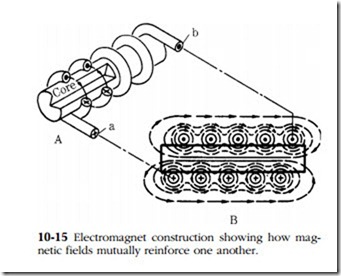Electromagnets
Electromagnets use electricity to produce a magnetic field. Electromagnets are used in starter solenoids, relays, and voltage-and current-limiting devices. The principle upon which these magnets operate was first enunciated by the Danish researcher Hans Christian Oersted. In 1820, he reported a rather puzzling phenomenon: A compass needle when placed near a conductor, deflected as the circuit was made and broken. Subsequently it was shown that the needle reacted because of the presence of a magnetic field at right angles to the conductor. The field exists as long as current flows, and its intensity is directly proportional to the amperage.
The field around a single strand of conductor is too weak to have practical application. But if the conductor is wound into a coil, the weak fields of the turns rein- force each other (Fig- 10-15). Further reinforcement can be obtained by inserting an iron bar inside the coil to give focus to the lines of force. The strength of the electromagnet depends on the number of turns of the conductor, the length/width ratio of the coil, the current strength, and the permeability of the core material.

